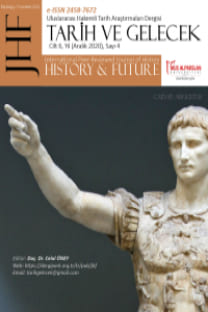Hindistan İstiklal Mücadelesinin Kahramanlarından Bal Gangadhar Tilak’ın Hayatı ve İcraatları
HİNT ALT KITASI, PASİF DİRENİŞ, Bal Gangadhar Tilak
The Life and Actıvıtıes of Bal Gangadhar Tılak, one of the Heroes of Indian Intelligence Struggle
TİLAK, İNDİAN SUBCONTİENT, PASSİVE RESİSTANCE,
___
- Baptısta, J., About Lokamanya Tilak, Vavilla Press, Madras 1922.
- Bhosale, B.G, Indıan Natıonalısm: Gandhı vis-a-vis Tılak and Savarkar, The Indian Journal of Political Science LXX/2, Indian Political Science Association, 2009
- Briggs, H.G., The Nizam His History and Relations with the British Government I- II, Delhi 1985.
- Cashman, R.I., The Myth od the Lokamanya Tilak and Mass Politics in Maharashtra, University of Calfornia Press, London 1975.
- Chandra, B., India’s Struggle for İndependence,New Delhi 1989.
- Desai, A. R, Social Bankround of India Nationalism, Bombay 1966.
- Dutt, R., The Economic History of India in the Victorian Age (from the Accession of Queen Victoria in 1837 to the Commencement of the Twentieth Century), London 1958.
- Edward, S.M., “The Final Struggle with the Marathas, 1784-1818”, The Cambridge History of India V; British India 1497-1858, (nşr.H.H. Dodwell), New Delhi 1958, s.379.
- Frazer, R.W., A Story of the Nations British India, London 1918.
- George, K.H., British Administration During The Revolt of 1857, New Delhi 1985.
- Ghose,B. A., Bal Gangadhar Tilak His Writings and Speeches, Ganesh, Madras 1922.
- Habermas, J., Sivil İtaatsizlik, (nşr.; Hayrettin Ökçesiz), Afa Yayınları, İstanbul 1995.
- Hopkins, E.W., “The Growth of Law and Legal Instituons”, The Cambridge History of India I, (nşr.E.J. Rapson), Delhi 1955. (s.259-270) Hunter, W.W., The Indian Musalmans, London 1871.
- Innes, A.D., A Short History of The British in India, New Delhi 1985.
- Yayın Aralığı: Yılda 4 Sayı
- Başlangıç: 2015
- Yayıncı: Celal ÖNEY
XVIII. Yüzyıl Osmanlı-Avusturya İlişkilerinde Diplomatik Temasın Görünen Yüzü: Hediyeleşme
Mehmet Ali Sorunu Süreci Boyunca II Mahmud ve Diplomatları
12 Mart Muhtırası ve Nihat Erim Hükümeti’nin Balyoz Harekâtı’nın Medyaya Yansıması
İngiliz Jeolog Warington Wilkinson Smyth’in Gözünden 1842 Yazında Tokat
Erken Modern Dönem İngiltere’sinde Vasiyetnamelerin Kaynak Olarak Kullanılması
Han Sultan’ın Berke Han’ın Annesi Olup Olmadığı Hususunda Mutâlaalar
Demokrat Parti Döneminde Türkiye’de Kültürel Faaliyetler (1946-1960)
Sağlıkla Gelen Bir Ziyaret: İsmet Paşa Bursa’da (8 -31 Temmuz 1927)
